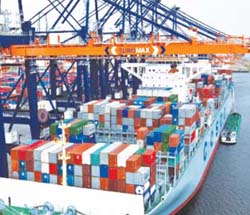By Mary Mwende Mbithi
 Air freight has for years been the sole mode of transport for flowers in the entire continent. With the international flower business growing substantially recently, sea transport is ‘the new kid in the block’. Coming just in handy as an alternative when the cost of air freight has shot up to $5.8 per kilo of cargo, is more of a milestone to the flower industry.
Air freight has for years been the sole mode of transport for flowers in the entire continent. With the international flower business growing substantially recently, sea transport is ‘the new kid in the block’. Coming just in handy as an alternative when the cost of air freight has shot up to $5.8 per kilo of cargo, is more of a milestone to the flower industry.
Kenya Flower Council’s CEO Clement Tulezi, says that, “sea freight is a solution to gaps left by air freight which amount to about 1500 tonnes per week and the air freight is not expanding. The only way forward is flowers by sea.”
According to Tulezi high freight charges have made produce from neighbouring countries like Ethiopia sell at by 2030. All in all, the use of both air and sea freigh would cut out Kenya as East Africa’s Horticultural lodestar.
So far Kenya has created a niche as a mega producer and exporter in horticulture earning the country’s GDP of more than 1% with the horticultural produce ranging from flowers to vegetables and fruits.
Flowers shipped by sea have less stress compared to those shipped by air. However, sea freight is not yet a common practice in the flower business.For instance, a major challenge is the duration it takes for roses from Kenya (about 30-35 days) to reach EU markets. This tells that poor handling and improper treatments may compromise on quality of flowers at their final destination. After arrival in Europe, roses should be able to withstand 3-4 day period in the retail channel and should have a remaining vase life of at least 7 days of acceptable quality. According to Van Doorn, of Chrysal, sea transport of flowers is cheaper than air transport, more flower-friendly and when all steps are adhered to, it gives better quality vase life. To reach the end consumer in a good state, flowers ought to be in right stable conditions and handled carefully.
Flowers set for sea freight are meant to follow a strict cold chain management as well as botrytis control in order to alleviate damages. Early openings, leaf desiccation and fungal infections also need good management. Speaking at the ‘Flowers by Sea’ conference held at Visa Oshwal Center in Nairobi, the Chrysal team talked of a protocol to manage these with pretreatment dip as the initial step before packing the flowers in a sea freight box customized to allow air flow in and out of the box.
According to Dennis Nyamweya of Kuenhe+Nagel, when shipping temperature-controlled goods like flowers, there is the need for reliable logistics that provides seamless cold chain transportation throughout the journey. Flowers via sea could take more than two weeks to their destination, therefore temperature should be maintained so as not to compromise on standards. Kuenhne + Nagel offers transport in reefer containers that are monitored around the clock with temperature controlled interventions in case of deviations in temperatures.
Jeroen van der Hulst, founder and managing director of Flower Watch says, “The implementation of sea freight in Kenya to Europe is a worthwhile development that makes the Kenyan industry more resilient, efficient and sustainable.
